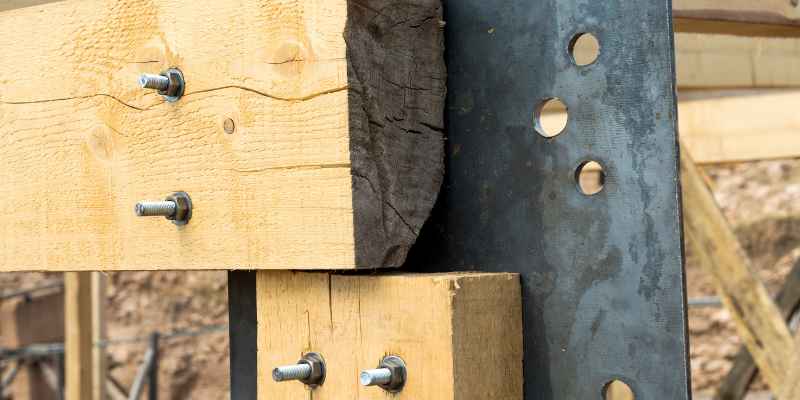A stressed joint wood is a type of wood joint that is specifically designed to withstand dynamic loads, such as those experienced by chairs or tables. This type of joint, often created using techniques like doweling or mortise and tenon, provides extra strength and stability to the furniture.
On the other hand, an unstressed joint wood is primarily used for decorative purposes or for carrying small static loads. While it may still offer some structural support, it is not intended to withstand heavy or dynamic loads. Overall, stressed joint woods are essential for ensuring the durability and longevity of furniture pieces that are subjected to frequent use and movement.
Understanding Joinery Basics
Understanding joinery basics includes learning about stressed joint wood, where compression forces bond the joint together for durability. By exploring various joint types, such as mortise and tenon, woodworkers can enhance a joint’s resistance to stress, ensuring a strong and reliable connection in their woodworking projects.
Types Of Basic Joints
A successful woodworking project heavily relies on strong and secure joints. Understanding the different types of basic joints is crucial for creating durable and visually appealing woodwork. Here are some common types of basic joints:
- Butt joint: The simplest and weakest joint, where two pieces of material are joined together at their ends without any special shaping or cutting.
- Miter joint: Made by cutting two pieces of wood at an angle and joining them together to form a 90-degree corner.
- Coped joint: Often used in decorative moldings, this joint involves cutting the end of one piece to fit the profile of the adjacent piece.
- Tongue-and-groove joint: Features a protruding “tongue” on one piece that fits into a corresponding groove on the other piece.
- Mortise and tenon joint: A strong and traditional joint where a projecting piece of wood (tenon) fits into a cavity (mortise) on the other piece.
- Half-lap joint: Requires cutting away half of the thickness of each piece so that they overlap and create a flush joint.
- Dado joint: Involves cutting a channel across the grain of one piece to fit the other piece snugly.
- Rabbet joint: Has a groove or recess cut into one piece to accommodate the edge of the other piece.
Types Of Joint Stress
Understanding the types of stress that joints experience is essential for designing and constructing solid woodwork. Here are some common types of joint stress:
| Joint Stress Type | Description |
|---|---|
| Compression Forces | The joint is being pressed together, causing the pieces to compress against each other. |
| Vertical Shear | The joint is subjected to forces that can cause the pieces to slide vertically against each other. |
| Torsion | The joint experiences twisting forces that can cause the pieces to rotate against each other. |
| Bending | The joint is subjected to forces that cause the pieces to flex or bend. |
By understanding these basic joint types and the potential stresses they may experience, woodworkers can create stronger and more durable woodwork that can withstand a variety of forces.
Exploring Strong Wood Joints
A stressed wood joint, such as a mortise and tenon joint, is a strong woodworking technique where a projecting piece of wood, or tenon, securely fits into a corresponding cavity, or mortise. This joint can be reinforced for added stability and strength, making it a reliable choice for durable woodwork projects.
The Strongest Wood Joint
Mortise and tenon joints are renowned for their incredible strength. This classic joint involves a tenon fitting snugly into a mortise cavity, often reinforced with glue or wedges for added stability.
The Weakest Wood Joint
A butt joint, the simplest form of joining wood, lacks the strength of more intricate joints due to its basic connection of two material ends without additional support.
Factors Affecting Wood Joint Strength
Wood joint strength greatly relies on the proper dry time of the glue used. Insufficient dry time can weaken the bond, affecting the overall strength of the joint. Ideally, allowing the glue to fully dry before removing clamps is crucial for optimal joint durability.
Various types of wood joints offer different levels of strength due to their structures and mechanisms. Understanding the characteristics of each joint type is essential for creating sturdy woodworking projects. Common joints include butt joints, miter joints, coped joints, tongue-and-groove joints, mortise joints, half-lap joints, dado joints, and rabbet joints.
The Science Behind Joinery
When it comes to woodworking, joinery is the foundation of creating sturdy and durable woodwork pieces. The science behind joinery lies in the different types of joints used to connect pieces of wood together. Each joint has its own unique characteristics, providing strength, stability, and aesthetic appeal to the final product.
Mortise And Tenon Joints
One of the strongest and most reliable joints in woodworking is the mortise and tenon joint. This traditional joint has withstood the test of time and is known for its remarkable strength. At its core, a mortise and tenon joint involves a projecting piece of wood, called a tenon, securely fitting into a corresponding cavity, known as a mortise. This interlocking mechanism creates a solid connection between the two pieces of wood.
Mortise and tenon joints can be further reinforced with glue or wedges for added stability and a stronger hold. This type of joint is often used in furniture making, cabinetry, and woodworking projects that require strength and durability.
Understanding Stressed Vs. Unstressed Wood Joints
When it comes to wood joints, it is important to understand the concept of stressed and unstressed joints. Stressed joints refer to the areas of the joint that bear the most load and are under the greatest pressure. These joints require careful planning and execution to ensure their strength and stability.
On the other hand, unstressed joints are those that do not bear significant loads or pressures. These joints can be simpler in design and execution, as they are not subject to the same level of stress as their counterparts.
By understanding the difference between stressed and unstressed joints, woodworkers can make informed decisions about the type of joint to use for different parts of their projects. This knowledge allows for the creation of strong and reliable woodwork pieces that can withstand the test of time.
Importance Of Avoiding Stressed Joints
When working with wood, it is crucial to understand the significance of avoiding stressed joints. Stressed joints can weaken the structural integrity of woodwork, leading to potential defects or failures. Therefore, it’s essential to delve into the effects of stress on wood joints and the role of glue in preventing joint stress.
Effects Of Stress On Wood Joints
Stress on wood joints can result in misalignment, warping, or even cracking, compromising the overall quality and durability of the project. This may lead to costly repairs or replacements, emphasizing the necessity of preventing stressed joints.
The Role Of Glue In Joint Stress
Glue plays a pivotal role in mitigating joint stress, as it enhances the adhesive strength, reinforcing the bonds between wood pieces. By choosing the appropriate adhesive and application method, the potential for joint stress can be minimized, ensuring a more robust and durable woodwork.
Expert Tips For Wood Joint Strength

Tips For Strengthening Wood Joints
When it comes to wood joint strength, implementing the right techniques and practices can significantly enhance the durability and stability of your woodworking projects. Whether you are a novice or a seasoned woodworker, the following expert tips can help you strengthen your wood joints and ensure the longevity of your creations.
- Use high-quality wood: Opt for strong and durable wood varieties, such as oak or maple, to provide a solid foundation for your joints.
- Proper measurement and cutting: Accurate measurements and precise cutting of the wood pieces are crucial for creating tight-fitting joints that can withstand stress.
- Utilize appropriate joinery techniques: Select the most suitable joinery methods, such as mortise and tenon, dovetail, or dado joints, based on the specific requirements of your woodworking project.
- Apply wood glue strategically: When bonding wood pieces together, ensure thorough and even application of wood glue to strengthen the joint.
Best Practices For Joinery
Implementing best practices for joinery is essential for maximizing the strength and resilience of wood joints. By adhering to these guidelines, you can enhance the structural integrity of your woodworking creations, making them capable of withstanding various stressors.
- Choose appropriate joint types: Select the most suitable joint types based on the specific load-bearing requirements and structural demands of your woodworking project.
- Focus on precision and accuracy: Pay careful attention to precision during the assembly process, ensuring tight fits and proper alignment of the joint components.
- Reinforce with mechanical fasteners: In addition to using wood glue, consider reinforcing the joints with mechanical fasteners like screws, dowels, or nails to provide extra strength and stability.
- Quality control and regular inspections: Regularly inspect and maintain your wood joints to identify any potential weaknesses or damage, allowing for timely repairs or reinforcements.
Frequently Asked Questions Of What Is A Stressed Joint Wood
What Is The Strongest Joint In Woodworking?
The strongest joint in woodworking is the mortise and tenon joint, known for remarkable strength. It involves a tenon fitting securely into a mortise, and can be reinforced with glue or wedges for a stronger hold.
What Is The Weakest Wood Joint?
The butt joint is the weakest wood joint as it involves joining two material ends without shaping or cutting.
How Long Should Wood Glue Dry Before Removing Clamps?
Wood glue should dry for a minimum of 24 hours before removing clamps.
What Are The 3 Wood Joints?
The three wood joints are butt joint, miter joint, and coped joint. Each serves different purposes in woodworking projects.
Conclusion
A stressed joint wood refers to a type of joint that is subject to dynamic or heavy loads, such as chairs or tables. These joints, like mortise and tenon or dowel joints, are designed to provide extra strength and stability.
On the other hand, unstressed joints are mainly decorative or used for carrying small static loads. Understanding the difference between stressed and unstressed joints is crucial in woodworking to ensure the durability and functionality of the piece.


